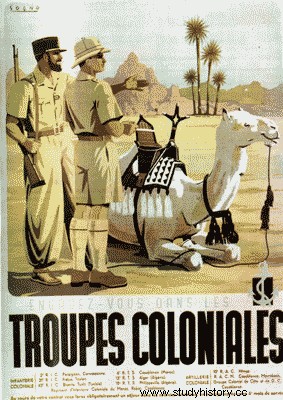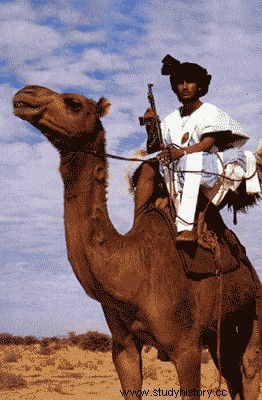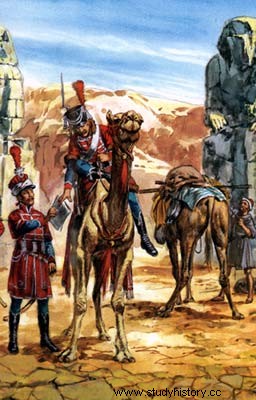-

- The Camel Riders
If we exclude the regiment of dromedaries created during the Egyptian campaign by Bonaparte, on 20 Nivôse Year VII (January 9, 1799), the first use of this animal in the French Army seems to be due to Faidherbe who ensures by this means its convoys and even the transport of infantry, but without setting up a specialized unit.
-

- The Camel Riders
He would be imitated by those in charge of penetration missions in the African hinterland, Monteil (1892), Lamy, Joalland and Meynier (18981899) and by the officers of the Sudanese spahis squadron, such as Laperrine (1897), who experienced the limits of the use of horses in arid areas as pack animals and even as mounts.
-

- The Camel Riders
However, it was in the northern Sahara, in El Goléa, that the first camel platoon was created in 1891; it was a failure. On December 5, 1894, the corps of Saharan skirmishers and spahis was created, the beginnings of which were laborious, the Spahis, mounted on horseback, proving to be more effective. The Colonial Army in the South was hardly happier. In 1897, Commander Klobb created a corps of camel drivers; it could not be used, the camels having all perished. The following year, Lieutenant Wirth at the head of forty-five skirmishers and a "platoon of camels" chased a Moorish razzi not far from Lake Faguibine and defeated it. In 1899, a second platoon under the orders of Lieutenant Meynier was engaged, in Bamba, against the Berabiches dissidents. Thus began the great epic of the colonial meharists who for nearly seventy years were to contribute to the conquest and then to the pacification of the southern Sahara, allowing the nomadic and sedentary populations of these immense regions to experience an exceptional period of peace.
In general, the nomadic units were organized in groups of one or more platoons, each with a section of skirmishers and a goum recruited locally from among the Regueibat, the Moors, the Kountas, the Tuaregs and the Toubous. According to the seasons, the possibilities and the missions, a grazing echelon was left behind while the platoons traversed their areas of responsibility being satisfied with uncertain resources. Long-range patrols were detached to cover remote or difficult-to-reach areas. Because, of course, the favorite areas of the nomadic units were those where the vehicles could not access or penetrated with great difficulty (mountainous areas, mainly ergs).
Unlike the meharist units of the northern Sahara, who had only local recruitment and lived part of the year in posts, often very far from grazing areas, the colonial meharists were permanently nomads, setting up their "squares » according to the movements of populations, resources and areas to be monitored; they fully justified their designation as nomadic units. Using no hardware, these rustic units had the advantage of being inexpensive and constantly available.
This active and harsh existence demanded trained, ardent, morally well-armed men, unconcerned about comfort, imaginative, curious to know men, environments and things and above all animated by a well-tempered ideal and a keen sense of contact with people. populations unaccustomed to life within local authorities.
On the other hand, what satisfactions among the camel riders from whom the nomads expected a lot and, in particular, justice, care, multifaceted aid to better take advantage of the Saharan space long forbidden because of insecurity and also to fit into the structures of a more modern society. Les Klobb, Wirth, Meynier, Théveniaut, Cauvin, Dromard, Bourgès, Plomion, Moll, Betrix, Théral, Berger, Gouspy, Larroque, Aubinière, Le Cocq, Brosset, Le Rumeur, Mear, Cayrol, Dio, Kerfanto, Sarrazac, Chapelle , Borricant, Garbit, Dessert, D'Ornano, Bacquié, Chavériat are some of these camel riders who trained so many young officers and non-commissioned officers who were to be among the most brilliant of . tear. Thus, it is they who will provide the fiery frameworks with which Leclerc will chase the Italians from Koufra and Fezzan, then continuing with the ride that we know. Some of their feats of arms are recounted in this book.
A certain nostalgia tinged with bitterness embraces those who have lived this life in the nomadic units when they see the sad future of these disadvantaged areas:displaced populations, bullied by a hesitant administration which takes a dim view of these nomads seeming to escape its control, decimated herds, return of insecurity, lack of authorities incapable of helping to better exploit the Saharan environment. What is even more serious, they deplore the rapid disappearance of the civilization of the desert, a consequence of the transformation of lifestyles and the loss of identity of the uprooted tribes which had known how to inspire such beautiful pages in Psichari, Saint-Exupéry , Diégo Brosset, Jean d'Esme, Chapelle...
In general, the nomadic groups consisted of a heavy echelon made up of a section of skirmishers on dromedaries and a goum recruited locally (Regueibats, Moors, Kountas, Touaregs, Toubous) and which provides lighting and "choufs" and ensures rapid connections, remounting operations, and surveillance of the pasture area. Unlike the camel riders of North Africa, who moreover only had local recruitment and who most often lived in garrisons sometimes very far from the pastures, the colonial camel riders adopted the tent and kept it until the end, their square always being located as close as possible to the pasture. Thus they live as close as possible to their men, their mounts and the populations, however sparse they may be, that they have a mission to protect.
It is difficult for us to imagine today what the life of these great ancients was like, whose ardor, imagination and rapidity of reaction were matched only by unfailing energy and unusual physical stamina. How else could they have accomplished their mission in a hostile environment where any impasse is suicidal, faced with harsh and ruthless warriors, of extreme frugality, who knew the desert admirably and whose only resource and philosophical motivation consisted in raiding herds and goods and to seize populations to reduce them to slavery? Captains Grodemange, Bouteil, Mangin, Le Cocq, who will find a glorious death in Indochina on March 9, 1945, Aubinière, Lieutenant Ferrandi are some of these meharists who trained so many young officers and non-commissioned officers who were to count among the brightest in the Army. They are mainly the ones who will provide Colonel Leclerc with the framework and the tool without which he would never have been able to reach Koufra or liberate Strasbourg.
Some of their feats of arms are recounted in this book. But what nostalgia seizes those who have shared or known their ardent and hard life, when they note that our withdrawal from these regions under the pretext of decolonization has been accompanied by a return to the norms of the past or, worse, the progressive loss of their identity by these proud and independent nomadic tribes who were our friends, who appreciated us and loved by men such as Psichari, Charles de Foucauld, Mermoz and, closer to us, Saint-Exupéry?
